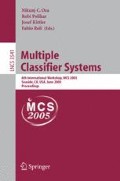Abstract
Spectra intrinsically possess domain knowledge, making possible a domain-based feature selection model. The random subspace method, in combination with domain-knowledge-based feature sets, leads to improved classification accuracies in real-life biomedical problems. Using such feature sets allows for an efficient reduction of dimensionality, while preserving interpretability of classification outcomes, important for the field expert. We demonstrate the utility of domain knowledge-based features for the random subspace method for the classification of three real-life high-dimensional biomedical magnetic resonance (MR) spectra.
Access this chapter
Tax calculation will be finalised at checkout
Purchases are for personal use only
Preview
Unable to display preview. Download preview PDF.
References
Ho, T.K.: The Random Subspace Method for Constructing Decision Forests. IEEE Transactions on Pattern Analysis and Machine Intelligence 20(8), 832–844 (1998)
Gunter, S., Bunke, H.: Feature selection algorithms for the generation of multiple classifier systems and their application to handwritten word recognition. Pattern Recognition Letters (25), 1323–1336 (2004)
Skurichina, M., Paclik, P., Duin, R., et al.: Selection/extraction of spectral regions for autofluorescence spectra measured in the oral cavity. In: Fred, A., Caelli, T.M., Duin, R.P.W., Campilho, A.C., de Ridder, D. (eds.) SSPR&SPR 2004. LNCS, vol. 3138, pp. 1096–1104. Springer, Heidelberg (2004)
Nikulin, A.E., Dolenko, B., Bezabeh, T., Somorjai, R.: Near-optimal region selection for feature space reduction: novel preprocessing methods for classifying MR spectra. NMR in Biomedicine (11), 209–216 (1998)
Kumar, S., Ghosh, J., Crawford, M.M.: Best–bases feature extraction algorithms for classification of hyperspectral data. IEEE Transactions on Geoscience and remote sensing 39(7), 1368–1379 (2001)
Zhilkin, P., Somorjai, R.: Application of several methods of classification fusion to magnetic resonance spectra. Connection science 8(3-4), 427–424 (1996)
Raudys, S., Somorjai, R., Baumgartner, R.: Reducing the overconfidence of base classifiers when combining their decisions. In: Windeatt, T., Roli, F. (eds.) MCS 2003. LNCS, vol. 2709, pp. 65–73. Springer, Heidelberg (2003)
Somorjai, R., Janeliunas, A., Baumgartner, R., Raudys, S.: Comparison of two classification methodologies on a real-world biomedical problem. In: Caelli, T.M., Amin, A., Duin, R.P.W., Kamel, M.S., de Ridder, D. (eds.) SPR 2002 and SSPR 2002. LNCS, vol. 2396, pp. 433–441. Springer, Heidelberg (2002)
Himmelreich, U., Somorjai, R.L., Dolenko, B., Lee, O.C., Daniel, H.-M., Mountford, C.E., et al.: Rapid Identification of Candida Species Using Nuclear Magnetic Resonance Spectroscopy and a Statistical Classification Strategy. Appl. Environ. Microbiol. 69, 4566–4574 (2003)
Somorjai, R.L., Dolenko, B., Nikulin, A., Nickerson, P., Rush, D., Shaw, A., Glogowski, M., Rendell, J., Deslauriers, R.: Distinguishing Normal Allografts from Biopsy - Proven Rejections: Application of a Three - Stage Classification Strategy to Urine MR and IR Spectra. Vibrational Spectroscopy 28(1), 97–102 (2002)
Skurichina, M., Duin, R.P.W.: Bagging, boosting and the random subspace method for linear classifiers. Pattern Analysis and Applications 5, 121–135 (2002)
Fukunaga, K.: Introduction to statistical pattern recognition. Academic Press, London (1991)
Shawe-Taylor, J., Christianini, N.: Kernel Methods for pattern analysis. Cambridge university press, Cambridge (2004)
Bertoni, A., Folgieri, R., Valentini, G.: Bio-molecular cancer prediction problem with random subspace ensembles of support vector machines. Neurocomputing (2005) (in press)
Ambroise, C., McLachlan, G.J.: Selection bias in gene extraction on the basis of microarray gene-expression data. Proc. Nat. Acad. Sci., USA, 99(10), 6562–6566 (2002)
Author information
Authors and Affiliations
Editor information
Editors and Affiliations
Rights and permissions
Copyright information
© 2005 Springer-Verlag Berlin Heidelberg
About this paper
Cite this paper
Pranckeviciene, E., Baumgartner, R., Somorjai, R. (2005). Using Domain Knowledge in the Random Subspace Method: Application to the Classification of Biomedical Spectra. In: Oza, N.C., Polikar, R., Kittler, J., Roli, F. (eds) Multiple Classifier Systems. MCS 2005. Lecture Notes in Computer Science, vol 3541. Springer, Berlin, Heidelberg. https://doi.org/10.1007/11494683_34
Download citation
DOI: https://doi.org/10.1007/11494683_34
Publisher Name: Springer, Berlin, Heidelberg
Print ISBN: 978-3-540-26306-7
Online ISBN: 978-3-540-31578-0
eBook Packages: Computer ScienceComputer Science (R0)

